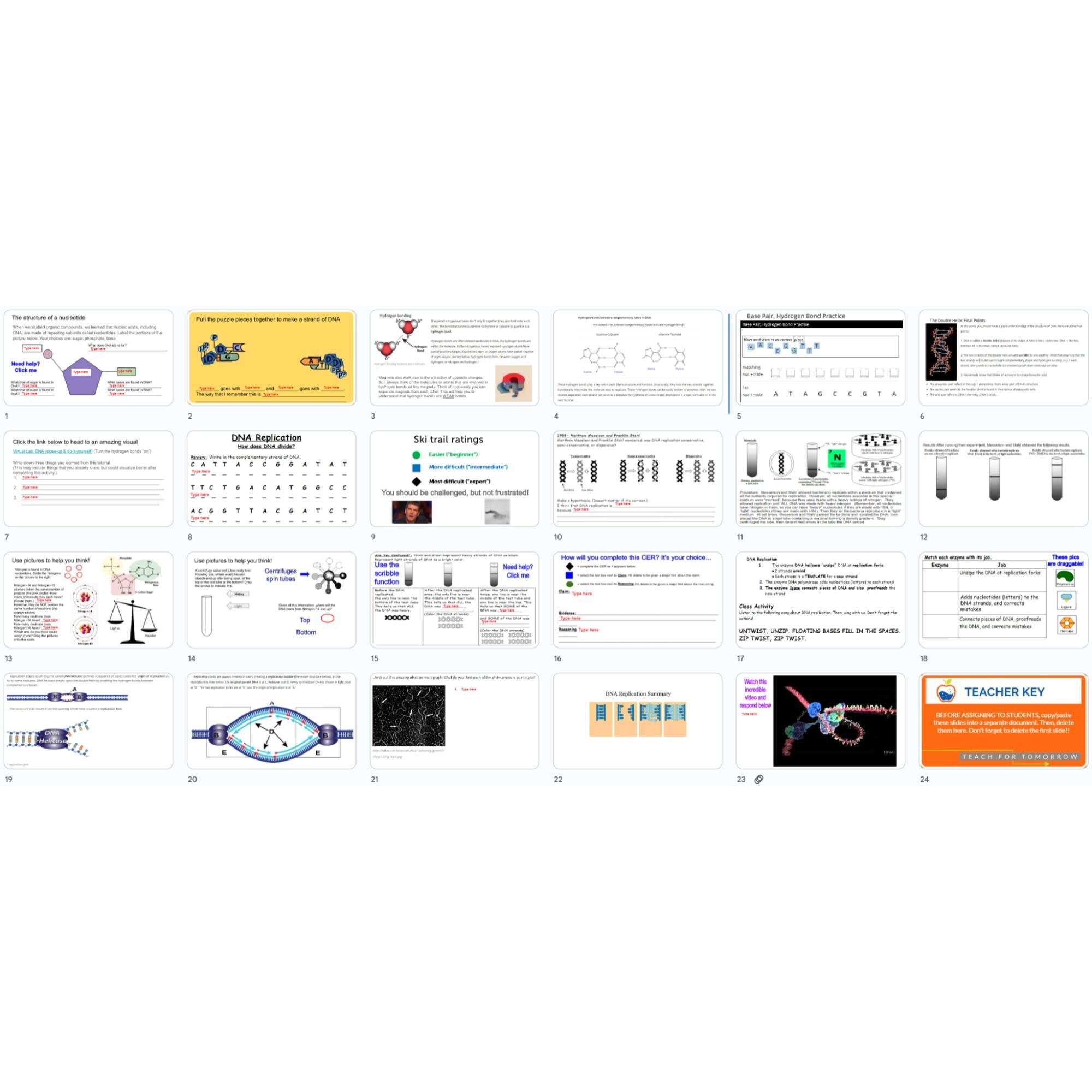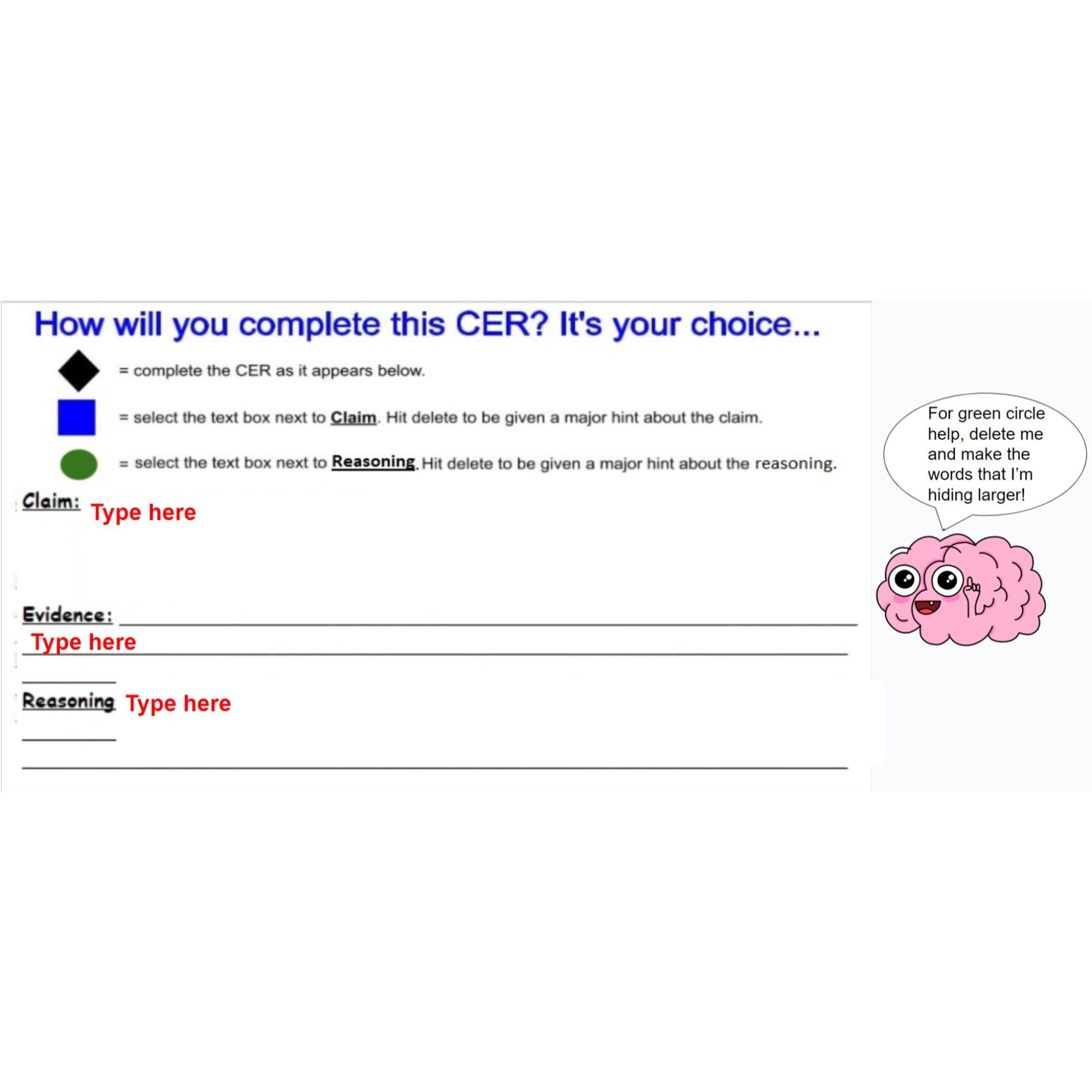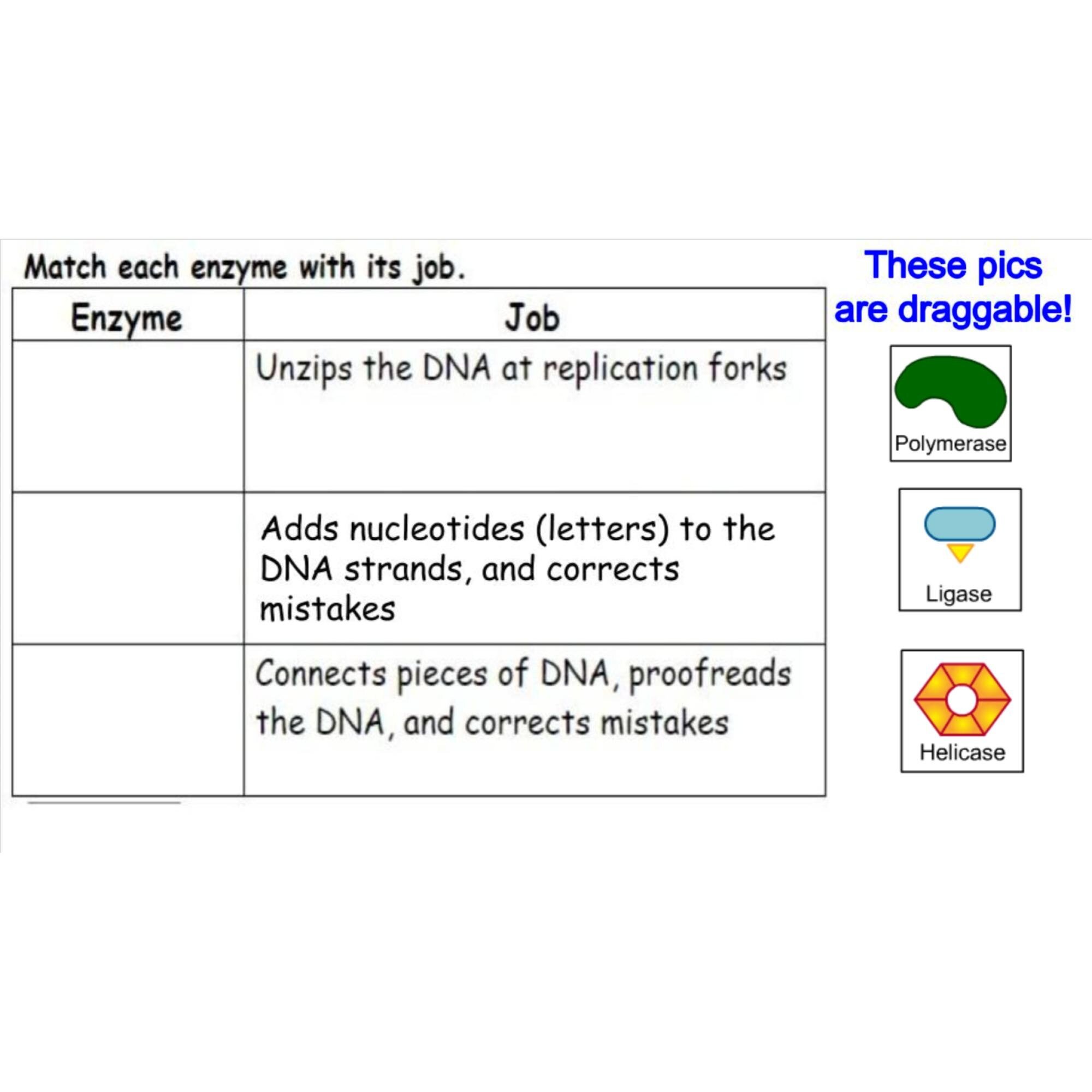 Image 1 of 4
Image 1 of 4

 Image 2 of 4
Image 2 of 4

 Image 3 of 4
Image 3 of 4

 Image 4 of 4
Image 4 of 4





DNA Structure and Replication
Embark on a DNA Discovery Journey with an Interactive Google Slides Lesson!
Unraveling the Secrets of DNA Replication: This engaging Google Slides lesson introduces students to the captivating world of DNA structure and replication. Perfectly suited for in person or remote learning, your students will grasp the intricacies of DNA replication in a snap!
Step-by-Step Learning Adventure:
Nucleotide Know-How: Students begin by labeling the structure of a nucleotide and exploring the distinctions between DNA and RNA. If they need help, a handy clickable link provides guidance.
Nucleotide Puzzling: Using draggable nucleotide puzzle pieces, students construct their own DNA strand, solidifying their understanding of DNA composition.
Balancing Bases: Students delve into hydrogen bonding and base pairing concepts. They apply their newfound knowledge by forming a complementary strand to a given DNA sequence.
Interactive 3D Modeling: Students manipulate a detailed 3D DNA model and describe their discoveries, enhancing their tactile understanding of DNA's structure.
Complementary Challenge: Students practice the essential skill of writing a complementary DNA strand, reinforcing their comprehension.
Meselson and Stahl Experiment: Students analyze this groundbreaking experiment that unveiled the semi-conservative nature of DNA replication. They draw conclusions, supported by clear explanations and visuals.
Enzymatic Chant and Dance: Students learn about key enzymes (helicase, polymerase, and ligase) involved in DNA replication. They cement their knowledge with a fun chant and dance routine, solidifying the sequence of replication steps.
Fork Insights: Students explore replication forks through detailed descriptions and images, gaining crucial insights into this vital process.
HHMI Video Extravaganza: Students immerse themselves in an extraordinary Howard Hughes Medical Institute video, providing an overview of DNA replication like never before.
Why Choose This Lesson?
Interactive Engagement: Keep students actively involved with hands-on activities and captivating visuals.
Comprehensive Learning: Covering DNA structure, replication, enzymes, and groundbreaking experiments, this lesson ensures a holistic understanding.
Remote Learning Ready: Tailored for seamless integration into remote learning environments.
Empower Scientific Understanding: Equip the students with invaluable insights into DNA. Download this interactive lesson now and watch their scientific knowledge flourish!
To preview this product, highlight the link below and paste the address into your web browser.
https://docs.google.com/presentation/d/13x8-tFFuEWYJKKx45S6Y7bIqmYpCb38Kyum7TMyuCmk/edit?usp=sharing
Grade & Course Recommendation:
Middle School: Grade 8 honors life science, introduction to DNA structure.
High School: Core Grade 9 Biology topic within molecular genetics.
Cross-Curricular Connections:
Math Integration: Students track complementary base pair ratios (A–T, G–C).
ELA Integration: Writing molecular explanations improves technical vocabulary and reasoning.
History of Science Integration: Ties to discovery milestones (Watson, Crick, Franklin).
Daily slide + literacy - based exit ticket included with purchase
Join the Lesson Laboratory and Teach for Tomorrow!
NGSS (Next Generation Science Standards)
HS-LS1-1: Construct an explanation based on evidence for how the structure of DNA determines the structure of proteins, which carry out the essential functions of life through systems of specialized cells. (connection: exploring DNA’s structure, base pairing, and replication process)
HS-LS1-6: Construct and revise an explanation based on evidence for how carbon, hydrogen, and oxygen from sugar molecules may combine with other elements to form amino acids and/or other large carbon-based molecules. (connection: linking nucleotide structure to biomolecular composition)
HS-LS3-1: Ask questions to clarify relationships about the role of DNA and chromosomes in coding the instructions for characteristic traits passed from parents to offspring. (connection: understanding how replication preserves genetic information)
HS-LS3-2: Make and defend a claim based on evidence that inheritable genetic variations may result from new genetic combinations, errors during replication, and/or mutations. (connection: emphasizing replication accuracy and its role in genetic stability)
Science & Engineering Practices: Developing and using models; Constructing explanations; Analyzing and interpreting data.
Crosscutting Concepts: Structure and function; Cause and effect; Systems and system models.
Common Core State Standards (ELA – Literacy in Science & Technical Subjects)
CCSS.ELA-LITERACY.RST.9-10.3 / RST.11-12.3: Follow precisely a multistep procedure when carrying out experiments or technical tasks. (connection: interpreting DNA replication models or simulations)
CCSS.ELA-LITERACY.RST.9-10.4 / RST.11-12.4: Determine the meaning of domain-specific words and phrases (e.g., “hydrogen bonds,” “nucleotide,” “semi-conservative replication”).
Embark on a DNA Discovery Journey with an Interactive Google Slides Lesson!
Unraveling the Secrets of DNA Replication: This engaging Google Slides lesson introduces students to the captivating world of DNA structure and replication. Perfectly suited for in person or remote learning, your students will grasp the intricacies of DNA replication in a snap!
Step-by-Step Learning Adventure:
Nucleotide Know-How: Students begin by labeling the structure of a nucleotide and exploring the distinctions between DNA and RNA. If they need help, a handy clickable link provides guidance.
Nucleotide Puzzling: Using draggable nucleotide puzzle pieces, students construct their own DNA strand, solidifying their understanding of DNA composition.
Balancing Bases: Students delve into hydrogen bonding and base pairing concepts. They apply their newfound knowledge by forming a complementary strand to a given DNA sequence.
Interactive 3D Modeling: Students manipulate a detailed 3D DNA model and describe their discoveries, enhancing their tactile understanding of DNA's structure.
Complementary Challenge: Students practice the essential skill of writing a complementary DNA strand, reinforcing their comprehension.
Meselson and Stahl Experiment: Students analyze this groundbreaking experiment that unveiled the semi-conservative nature of DNA replication. They draw conclusions, supported by clear explanations and visuals.
Enzymatic Chant and Dance: Students learn about key enzymes (helicase, polymerase, and ligase) involved in DNA replication. They cement their knowledge with a fun chant and dance routine, solidifying the sequence of replication steps.
Fork Insights: Students explore replication forks through detailed descriptions and images, gaining crucial insights into this vital process.
HHMI Video Extravaganza: Students immerse themselves in an extraordinary Howard Hughes Medical Institute video, providing an overview of DNA replication like never before.
Why Choose This Lesson?
Interactive Engagement: Keep students actively involved with hands-on activities and captivating visuals.
Comprehensive Learning: Covering DNA structure, replication, enzymes, and groundbreaking experiments, this lesson ensures a holistic understanding.
Remote Learning Ready: Tailored for seamless integration into remote learning environments.
Empower Scientific Understanding: Equip the students with invaluable insights into DNA. Download this interactive lesson now and watch their scientific knowledge flourish!
To preview this product, highlight the link below and paste the address into your web browser.
https://docs.google.com/presentation/d/13x8-tFFuEWYJKKx45S6Y7bIqmYpCb38Kyum7TMyuCmk/edit?usp=sharing
Grade & Course Recommendation:
Middle School: Grade 8 honors life science, introduction to DNA structure.
High School: Core Grade 9 Biology topic within molecular genetics.
Cross-Curricular Connections:
Math Integration: Students track complementary base pair ratios (A–T, G–C).
ELA Integration: Writing molecular explanations improves technical vocabulary and reasoning.
History of Science Integration: Ties to discovery milestones (Watson, Crick, Franklin).
Daily slide + literacy - based exit ticket included with purchase
Join the Lesson Laboratory and Teach for Tomorrow!
NGSS (Next Generation Science Standards)
HS-LS1-1: Construct an explanation based on evidence for how the structure of DNA determines the structure of proteins, which carry out the essential functions of life through systems of specialized cells. (connection: exploring DNA’s structure, base pairing, and replication process)
HS-LS1-6: Construct and revise an explanation based on evidence for how carbon, hydrogen, and oxygen from sugar molecules may combine with other elements to form amino acids and/or other large carbon-based molecules. (connection: linking nucleotide structure to biomolecular composition)
HS-LS3-1: Ask questions to clarify relationships about the role of DNA and chromosomes in coding the instructions for characteristic traits passed from parents to offspring. (connection: understanding how replication preserves genetic information)
HS-LS3-2: Make and defend a claim based on evidence that inheritable genetic variations may result from new genetic combinations, errors during replication, and/or mutations. (connection: emphasizing replication accuracy and its role in genetic stability)
Science & Engineering Practices: Developing and using models; Constructing explanations; Analyzing and interpreting data.
Crosscutting Concepts: Structure and function; Cause and effect; Systems and system models.
Common Core State Standards (ELA – Literacy in Science & Technical Subjects)
CCSS.ELA-LITERACY.RST.9-10.3 / RST.11-12.3: Follow precisely a multistep procedure when carrying out experiments or technical tasks. (connection: interpreting DNA replication models or simulations)
CCSS.ELA-LITERACY.RST.9-10.4 / RST.11-12.4: Determine the meaning of domain-specific words and phrases (e.g., “hydrogen bonds,” “nucleotide,” “semi-conservative replication”).